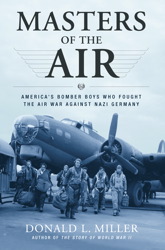About Masters of the Air
In Masters of the Air: America’s Bomber Boys Who Fought the Air War Against Nazi Germany, celebrated historian Donald L. Miller—author of the widely praised The Story of World War II—has written a riveting account of the stoic courage of these men and boys of the Greatest Generation. Drawing on hundreds of oral history interviews with surviving airmen and civilians who were victims of the bombing campaigns in Great Britain and Europe, as well as unpublished diaries and letters and recently de-classified government documents, Miller recreates the shattering experience of bombing, in the air and on the ground. While his focus is on the boys in the bombers, his is one of the only books on the air war to document in compelling detail the physical and mental horrors of being under the bombs, in German cities.
“The history of the American air war against Germany is the story of an experiment: the testing of a new idea of warfare,” Miller writes. “American bomber crews learned to fight the air war by experience and experiment, every mission a learning exercise. It was a special kind of experience, different from that of the ground forces.” Before joining the Air Force, most bomber crewmen had never even flown in a plane. In the first two years of bombing from their bases in eastern England, the Eighth Air Force sustained staggering losses on missions that had little impact on the German war economy. Miller’s deeply personal story captures the anxiety and terror on these flights, where frostbite, oxygen deprivation and psychological strain were even greater threats than enemy fighters and flak guns. In the early years of the war only one airman in four survived his required 25 missions.
The story of the Eighth Air Force is one of equal parts bravery, terror, and glamour, with some of its men becoming the most celebrated personalities the war. Miller chron icles the heroic feats of Robert Morgan, pilot of the legendary Memphis Belle; of Paul Tibbets, who later would fly the Enola Gay on the A-bomb mission to Hiroshima; of Curtis LeMay, the most celebrated combat leader of the bomber war; and—one of the key figures of the book—of Robert “Rosie” Rosenthal, leader of the Bloody Hundredth, who flew 52 combat missions, w
icles the heroic feats of Robert Morgan, pilot of the legendary Memphis Belle; of Paul Tibbets, who later would fly the Enola Gay on the A-bomb mission to Hiroshima; of Curtis LeMay, the most celebrated combat leader of the bomber war; and—one of the key figures of the book—of Robert “Rosie” Rosenthal, leader of the Bloody Hundredth, who flew 52 combat missions, w
as shot down three times, and later became a member of the team of prosecuting attorneys at the Nuremberg Trials.
The Anglo-American bombing campaign against Nazi Germany was the longest military campaign of the World War II, a war within a war. Until Allied troops crossed into Germany in the final months of the war, it was the only battle fought inside the German homeland. But strategic bombing was not effective until the appearance in late 1943 of a miracle plane, the P-51 Mustang, a long-range fighter escort that helped the Allies achieve the air supremacy over Northern Europe. That, in turn, allowed the D-Day invasion to go forward and also opened the way for the destruction, through cataclysmic bombing, of the German war machine.
The exploits of the Eighth Air Force were captured for the home front by the “Writing 69th,” a group of war correspondents that included Walter Cronkite and Andy Rooney. Flying on combat missions, these journalists sent home “you are there” dispatches about the Bomber Boys. Hollywood director William Wyler flew on Memphis Belle and made one of the most famous war documentaries ever filmed. Even movie stars joined the Eighth Air Force, among them Clark Gable, who eschewed any special treatment, and Jimmy Stewart, who become one its most decorated air commanders.
This is not just a story of war in the air. Miller tells the stories of captured airmen in German prison camps, including Stalag Luft III, scene of the largest prison break of the war, later depicted in the movie The Great Escape, and Stalag 17, also made famous on film. POWs, evacuated from camps by the SS late in the war as the Red Army advanced, undertook grueling forced marches, dying in great numbers, and witnessing the devastation they had caused with their bombs. French and Belgian resistance fighters risked their lives rescuing downed airman—and were often executed for their efforts. One airman who was shot down in Nazi-occupied France and escaped across the Pyrenees with the help of these heroic leaders of the European Resistance was fighter pilot Chuck Yeager, who later gained fame as a test pilot.
Masters of the Air is a story, as well, of life in wartime England, in bombed-out London, as well in the tiny hamlets these brash young Americans completely transformed. Many airmen fell in love with British girls they met in the local pubs, and over 45,000 American servicemen took English brides and brought them home after the war.
Miller gives full coverage to the morality of strategic bombing. He argues that while the 8th Air Force, as opposed to British Royal Air Force, concentrated on industrial targets and did not set city-consuming fires, as the RAF did at Dresden, it did conduct terror bombing—the indiscriminate bombing of non-combatants—in an effort to shorten the war in early 1945. Many bomber boys, and some 8th Air Force commanders, including General Jimmy Doolittle, expressed strong moral reservations about these raids.
Prominent journalists and historians have insisted that strategic bombing failed to curtail German production and that urban bombing actually strengthened the will of the German people to resist. Miller argues differently. He concludes that strategic bombing did not win the European war, but that the war could not have been won without it.


0 Comments
1 Pingback